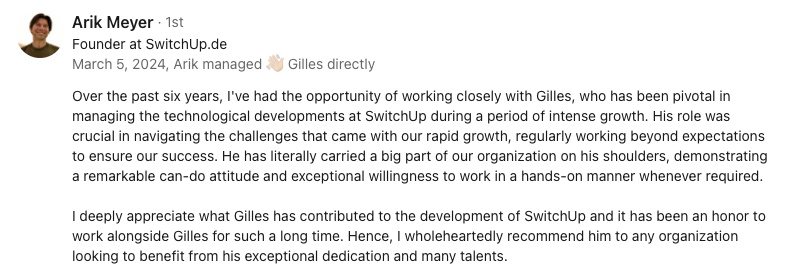Abstract:
For technology leaders, mastering C++ is not merely about understanding syntax and algorithms but also about leveraging this powerful programming language to drive innovation and performance. This article explores advanced C++ concepts and techniques that are crucial for CTOs and Directors of Technology aiming to enhance their team's efficiency and product quality. It discusses the significance of optimizing code for performance, the value in refactoring and modernizing legacy systems, and how to implement coding best practices to reduce errors and increase maintainability. Moreover, the piece highlights the importance of adopting a strategic approach towards software development, with an emphasis on continuous learning and adaptation to new standards in C++. Through this exploration, tech leaders will gain insights into making informed decisions that not only elevate their own skills but also set a high standard of excellence for their engineering teams.
Strategic importance of C++ for tech leaders
Understanding the strategic importance of mastering C++ is crucial for tech leaders aiming to drive innovation and performance in their teams. This versatile and powerful language is more than just basic syntax and algorithms. For CTOs and Directors of Technology, deep expertise in C++ can significantly enhance the efficiency and quality of their products. C++ is widely known for its performance advantages, offering fine-grained control over system resources, which is essential in areas like game development, real-time simulations, and high-frequency trading platforms.
By mastering advanced C++ techniques, tech leaders can unlock numerous benefits, such as:
- Optimized Performance: Knowing how to tweak and optimize code to run faster and more efficiently can dramatically improve application performance.
- System-Level Programming: Proficiency in C++ allows leaders to work closely with hardware, which is critical in developing systems-level applications.
- Legacy System Modernization: Many established systems and applications still leverage C++, and having the ability to refactor and modernize these systems is invaluable.
For tech leaders, an advanced understanding of C++ can significantly contribute to their team's overall success. It involves not just writing code but architecting systems that are robust, scalable, and maintainable. When leaders possess a deep knowledge of C++, they can better guide their teams, ensuring that the solutions developed are high-quality and meet performance standards. Thus, mastering C++ is a cornerstone for tech leaders striving to push the envelope and deliver innovative and efficient technology solutions.
Optimizing C++ code for performance
Performance optimization is a vital aspect for tech leaders who aim to craft top-notch tech solutions. Mastering C++ offers a deeper understanding, enabling leaders to leverage various sophisticated techniques that significantly enhance code effectiveness. The efficiency of an application can be the difference between success and failure, especially in high-stakes industries where every millisecond counts.
Advanced techniques for low-level memory management
One of the core strengths of C++ lies in its ability to manage memory at a granular level. By taking control of memory allocation and deallocation, tech leaders can ensure better performance and resource utilization. Techniques such as custom memory allocators, pool allocation, and minimizing memory fragmentation are crucial. These methods not only reduce overhead but also enhance an application's speed, which is critical for high-performance software like video games and real-time systems.
Harnessing compile-time optimizations
Compile-time optimizations play a pivotal role in refining C++ code. Utilizing features like inline functions, template metaprogramming, and constexpr can yield significant performance gains. These tools allow the compiler to perform optimizations during the compilation process, reducing runtime overhead. Leaders who are adept at applying these techniques can create systems that are both efficient and resilient to the ever-growing demands of users.
Making use of hardware-specific features
Understanding and utilizing hardware-specific features is another strategy for optimization. This involves leveraging specific instructions sets provided by modern CPUs, such as SIMD (Single Instruction, Multiple Data) for parallel processing. By tailoring code to make the most of available hardware, leaders can push performance boundaries, ensuring applications run swiftly and efficiently. This is particularly important in areas like scientific computing and financial modeling, where processing power and speed are paramount.
Why performance optimization matters for tech leaders
For tech leaders, focusing on performance optimization is not just about making software faster—it's about creating a superior user experience. Optimized applications are often more responsive, stable, and able to handle more significant workloads with ease. This forward-thinking approach to coding translates into products that meet high standards and surpass competitors.
- Efficiency Gains: Properly optimized code uses system resources effectively, conserving power and reducing operational costs.
- Improved User Experience: Faster, more responsive applications lead to satisfied users and better market adoption.
- Enhanced Product Quality: High-performance applications often exhibit fewer bugs and crashes, resulting in more robust solutions.
Examples of successful optimization efforts
Consider a case study from the gaming industry, where frame rate and responsiveness are critical. An optimization effort might involve rewriting rendering algorithms to reduce latency and improve visual performance, directly impacting user satisfaction. Similarly, in high-frequency trading, performance-tuned algorithms can handle vast amounts of data with minimal delay, providing traders with a competitive edge.
Another example comes from tech giants working on systems-level software. Engineers might engage in a rigorous process of profiling and optimizing their operating systems, ensuring they exploit the full potential of underlying hardware. This results in faster boot times and more efficient multitasking—an essential requirement in enterprise environments.
In summary, mastering the art of optimizing C++ code not only enhances application performance but also drives product quality and user satisfaction. For tech leaders, these skills are paramount in guiding their teams towards creating solutions that stand out in a crowded market. Through meticulous memory management, advanced compile-time techniques, and hardware-specific optimizations, tech leaders can deliver exceptional results that push the boundaries of what their products can achieve.
Refactoring and modernizing legacy systems
Tackling the task of refactoring and modernizing legacy C++ systems is both a challenge and an opportunity for tech leaders. Older codebases often contain a wealth of valuable functionality, but to stay competitive, it's crucial to bring them up-to-date with modern coding standards and techniques. Refreshing these systems allows teams to leverage the latest advancements in C++, enhancing performance, maintainability, and overall efficiency.
Challenges in updating older codebases
Upgrading legacy systems comes with unique hurdles. One of the primary issues is the complexity of monolithic code structures that have evolved over time. These large, intertwined systems can be cumbersome to update and debug. Additionally, documentation might be sparse or outdated, making it challenging for new team members to understand the existing architecture. Despite these obstacles, the effort is well worth it, as modernizing codebases can lead to significant long-term benefits.
Best practices for refactoring code
When diving into refactoring, several best practices can help simplify the process and improve outcomes:
- Break down monolithic structures: Start by decomposing large, complex modules into smaller, more manageable components. This modular approach makes the codebase easier to test, maintain, and understand.
- Implement modular designs: Shift towards designs that emphasize reusability and encapsulation. This reduces dependency between various parts of the system, making future updates and enhancements more straightforward.
- Leverage modern C++ features: Utilize contemporary C++ features like smart pointers, lambda expressions, and the STL (Standard Template Library) to improve performance and code readability.
- Ensure thorough testing: Develop comprehensive test cases to validate functionality at each stage of the refactoring process. This helps catch errors early and ensures that changes don't introduce new issues.
Opportunities and benefits from modernization
Modernizing legacy systems can unlock various advantages for tech leaders:
- Improved maintainability: Modern, modular code is inherently easier to maintain. The clearer structure and reduced dependencies simplify updates and bug fixes.
- Reduced technical debt: By addressing outdated and problematic code early on, teams can minimize future maintenance costs and avoid accumulating technical debt.
- Enhanced team productivity: A more organized and up-to-date codebase allows developers to be more productive. They can focus on innovation and new feature development rather than struggling with unwieldy legacy code.
Successfully modernizing a legacy system can also lead to better performance and increased stability. As systems become easier to work with, teams can implement additional optimizations and improvements, ultimately delivering a superior product. Leaders who prioritize modernization projects demonstrate a commitment to quality and sustainability, fostering a culture of continuous improvement within their organizations.
In conclusion, while refactoring and updating legacy C++ systems may seem daunting, the rewards far outweigh the challenges. By employing best practices and embracing modern C++ features, tech leaders can transform outdated codebases into streamlined, efficient, and maintainable systems. This not only positions their teams for success but also ensures their products remain competitive and high-performing in a fast-paced industry.
Implementing coding best practices to reduce errors and increase maintainability
Adhering to coding best practices is essential for tech leaders who aim to minimize errors and ensure the maintainability of their C++ projects. These practices create a structured environment where quality is prioritized, and teams can work more efficiently. One of the primary benefits of following best practices is the substantial reduction in bugs, which enhances overall product reliability.
Key best practices
Tech leaders should focus on several key practices, including:
- Code reviews: Regularly conducting code reviews ensures that all code meets project standards and catches potential issues early. This collaborative approach also promotes knowledge sharing among team members.
- Consistent coding standards: Establishing and adhering to a uniform coding style makes the codebase more understandable and easier to navigate. Consistency helps new developers quickly adapt and contributes to fewer errors overall.
- Automated testing: Implementing automated tests, including unit tests and integration tests, helps identify problems before they reach production. This automation accelerates the development process by providing immediate feedback on code changes.
Benefits of best practices
By implementing these practices, tech leaders can enjoy several advantages:
- Minimized bugs: A rigorous code review process and consistent standards significantly reduce the number of bugs, leading to a more stable and reliable product.
- Streamlined development: With clear guidelines and automated tests, the development process becomes more efficient, allowing teams to focus on delivering features rather than fixing issues.
- High-quality coding culture: Emphasizing best practices helps cultivate a culture of excellence where every team member is committed to delivering top-tier code. This approach fosters teamwork and continuous improvement.
Tech leaders who prioritize best practices ensure their teams can produce high-quality, maintainable code, positioning their projects for success. By fostering a disciplined and collaborative environment, they pave the way for innovation and efficient problem-solving.
Adopting a strategic approach to continuous learning and adaptation in C++
Adopting a strategy for ongoing learning and adjusting to new C++ standards is essential for tech leaders aiming to stay at the forefront of their field. Proactively pursuing professional growth and staying informed about the latest advancements in C++ can provide significant advantages. By engaging in industry conferences, participating in specialized forums, and regularly reviewing updated standards, leaders can foster an environment that values knowledge and innovation.
Staying ahead with new C++ standards
New standards consistently bring improvements and innovative features that tech leaders should leverage to maintain a competitive edge. Familiarity with the latest versions of C++ ensures that leaders and their teams benefit from enhanced performance, security, and usability features. Incorporating these advancements into projects can make a substantial difference in the final product quality.
Participating in industry events
Attending industry conferences, webinars, and workshops is a powerful way for tech leaders to stay updated and inspired. These events offer opportunities to learn from experts, network with peers, and exchange insights on best practices. By participating actively in these gatherings, leaders can bring fresh ideas and cutting-edge techniques back to their teams.
Encouraging team-wide learning
Promoting a culture of continuous learning within the team is just as crucial as personal growth. Encouraging team members to pursue certifications, attend training sessions, and participate in coding challenges can significantly enhance overall team expertise. Leaders who prioritize continuous learning set a standard for excellence that inspires their teams to achieve more.
Benefits of continuous improvement
Embracing continuous improvement in C++ skills can offer numerous benefits:
- Innovation: Staying current with C++ advancements drives creativity and the ability to implement new, innovative solutions.
- Higher Code Quality: Continuous learning reduces the likelihood of coding errors and enhances the maintainability of projects.
- Leadership Example: By demonstrating a commitment to ongoing education, leaders can inspire their teams to adopt a similar mindset, promoting a culture of excellence and adaptability.
In essence, a strategic approach to learning and adaptation not only strengthens a tech leader's proficiency but also sets a powerful example for their teams. This commitment to growth and excellence paves the way for creating superior, high-performing products that can stand out in the competitive tech industry.
Concluding insights on the impact of advanced C++ mastery for tech leadership
Mastering C++ provides tech leaders with a substantial edge. Skilled C++ leaders can utilize optimized code, revitalize legacy systems, implement best practices, and foster continuous learning. Each of these elements contributes to a team's success, driving innovation and performance. By elevating their proficiency, CTOs and Directors of Technology can lead with confidence, ensuring their teams produce top-tier, competitive solutions that stand out in the tech industry.














